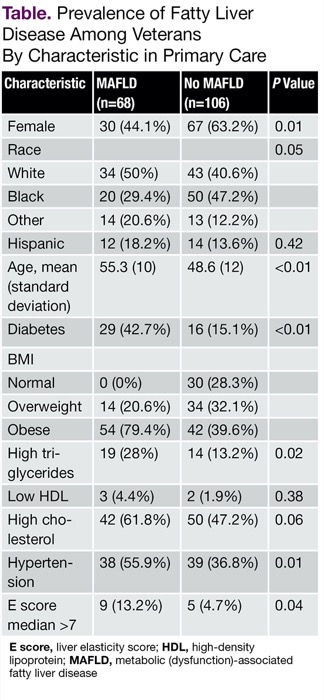New research has found that nearly half of patients who receive care at Veterans Health Administration hospitals have risk factors for liver disease. Yet, fewer than 10% of patients with these risk factors and markedly abnormal fibrosis scoring or transient elastography receive a diagnosis of cirrhosis.
The investigators hope to use these data to encourage population-level screening for advanced liver disease, an effort they say may ultimately enable earlier intervention.
“Unfortunately, many of our patients with cirrhosis are discovered in the later stages of their disease process,” said Lauren Beste, MD, the director of data and analytics for the VA’s HIV, Hepatitis & Related Conditions Program office, in Seattle. “But when you look back, you often realize they had signs of cirrhosis that didn’t get picked up, sometimes for years. Our motivation for the study was to see how many patients have risk factors for liver disease as well as other corroborating findings that might indicate they have undiagnosed cirrhosis.”
The population of interest comprised patients in VA care in 2018, who demonstrated risk factors for cirrhosis—chronic viral hepatitis, alcohol use disorder, obesity or diabetes—and had no prior diagnosis of the disease.
Dr. Beste and her colleagues also examined the proportion of patients who underwent liver-related testing in the preceding 24 months, including imaging, transient elastography or laboratory components of the FIB-4 score. They defined potential cirrhosis in two ways: liver stiffness greater than 12 kPa or a FIB-4 score above 3.25. The researchers also identified patients who received a diagnosis of cirrhosis or experienced a decompensation event in the 2018-2019 period.
The analysis found 6,658,875 patients in 2018 who did not have a prior diagnosis of cirrhosis. Of these, 45.4% had at least one risk factor for liver disease (diabetes or obesity, 70%; alcohol use, 26%).
High Risk, High Concern
Of the 3,023,074 patients with such risk factors, 87.5% (n=2,644,952) underwent liver-related testing. Of this group, 133,636 had markedly abnormal FIB-4 or transient elastography results. Despite these findings, only 9.7% of patients with risk factors and abnormal screening results received a diagnosis of cirrhosis.
“These are really high-risk patients, yet less than 10% received a formal diagnosis of cirrhosis,” Dr. Beste told Gastroenterology & Endoscopy News. “This is concerning to us because it’s likely that many of the patients who have these abnormal scores also have unrecognized cirrhosis. Certainly not everyone with liver disease risk factors and a high-risk screening score will end up truly having cirrhosis, but we strongly suspect it’s more than 9.7% of them.”
One-third of patients who were formally diagnosed with cirrhosis decompensated in the first year after their diagnosis, she noted.
Patients who received a diagnosis of cirrhosis were younger (66.3 vs. 73.4 years), more likely to have hepatitis C virus (30% vs. 11%) or alcohol use disorder (46 vs. 29%), and less likely to have diabetes or obesity (65% vs. 40%) than their counterparts without the diagnosis, according to the researchers.
The findings point to the existence of a significant pool of patients who likely have cirrhosis and require further evaluation and referrals, said Dr. Beste, who added that population-level screening may help identify many of them.
“We need to raise awareness of what constitutes a concerning result,” she said. “The next step is to figure out how to bring this to the forefront of providers’ attention when they’re seeing patients in their office. We have an opportunity to help providers recognize patients at high risk for cirrhosis and encourage further workup.”
Heather M. Patton, MD, the director of population management and hepatology at the VA San Diego Healthcare System, called the study “important” for several reasons.
“Timely recognition and referral of patients with cirrhosis is imperative in order to offer opportunity to impact disease progression and long-term outcomes,” said Dr. Patton, who expressed dismay that so few patients received a diagnosis of cirrhosis. “This, along with the high rate of decompensation in the year following diagnosis, indicates that we are routinely missing opportunities to treat liver disease before morbidity and mortality are imminent.”
Dr. Patton also expressed concern that so many veterans had at least one risk factor for liver disease. “The extremely high prevalence of risk factors for liver disease in our veterans should serve as a strong impetus to develop mechanisms for population-based screening to identify patients with advanced liver disease,” she said.
—Michael Vlessides
The study was presented at The Liver Meeting Digital Experience 2020 (abstract 661). Drs. Beste and Patton reported no relevant financial disclosures. Both Drs. Beste and Patton noted that the views expressed in the article are those of the interviewees and do not necessarily reflect the position or policy of the Department of Veterans Affairs.
This article is from the August 2021 print issue.



